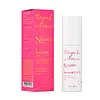What's inside
What's inside
 Key Ingredients
Key Ingredients

 Benefits
Benefits

 Concerns
Concerns

 Ingredients Side-by-side
Ingredients Side-by-side

Water
Skin ConditioningHydrogenated Farnesene
EmollientPolyglyceryl-3 Distearate
EmulsifyingBetaine
HumectantCoco-Caprylate/Caprate
EmollientTrehalose
HumectantPanthenol
Skin ConditioningCetearyl Alcohol
EmollientGlycerin
HumectantOrbignya Oleifera Seed Oil
EmollientPropylheptyl Caprylate
EmollientPropanediol
SolventCentella Asiatica Extract
CleansingCyanocobalamin
Skin ConditioningAllantoin
Skin ConditioningBisabolol
MaskingInulin
Skin ConditioningCellulose
AbsorbentFructose
HumectantGlucose
HumectantGlycine Soja Oil
EmollientTocopherol
AntioxidantTocopheryl Acetate
AntioxidantLactic Acid
BufferingTetrasodium Glutamate Diacetate
Glyceryl Stearate Citrate
EmollientCellulose Gum
Emulsion StabilisingXanthan Gum
EmulsifyingSodium Hydroxide
BufferingPhenoxyethanol
PreservativeWater, Hydrogenated Farnesene, Polyglyceryl-3 Distearate, Betaine, Coco-Caprylate/Caprate, Trehalose, Panthenol, Cetearyl Alcohol, Glycerin, Orbignya Oleifera Seed Oil, Propylheptyl Caprylate, Propanediol, Centella Asiatica Extract, Cyanocobalamin, Allantoin, Bisabolol, Inulin, Cellulose, Fructose, Glucose, Glycine Soja Oil, Tocopherol, Tocopheryl Acetate, Lactic Acid, Tetrasodium Glutamate Diacetate, Glyceryl Stearate Citrate, Cellulose Gum, Xanthan Gum, Sodium Hydroxide, Phenoxyethanol
Water
Skin ConditioningDicaprylyl Carbonate
EmollientLinoleic Acid
CleansingGlycerin
HumectantPolyglyceryl-6 Stearate
EmollientPrunus Amygdalus Dulcis Oil
Skin ConditioningInulin
Skin ConditioningPhenoxyethanol
PreservativeSclerotium Gum
Emulsion StabilisingAlpha-Glucan Oligosaccharide
CleansingStearyl Alcohol
EmollientPhospholipids
Skin ConditioningSodium Benzoate
MaskingXanthan Gum
EmulsifyingPotassium Cetyl Phosphate
EmulsifyingCeramide NP
Skin ConditioningPolyglyceryl-6 Behenate
Emulsion StabilisingCetearyl Alcohol
EmollientLinolenic Acid
CleansingEthylhexylglycerin
Skin ConditioningCeramide Ng
Skin ConditioningCitric Acid
BufferingTocopherol
AntioxidantWater, Dicaprylyl Carbonate, Linoleic Acid, Glycerin, Polyglyceryl-6 Stearate, Prunus Amygdalus Dulcis Oil, Inulin, Phenoxyethanol, Sclerotium Gum, Alpha-Glucan Oligosaccharide, Stearyl Alcohol, Phospholipids, Sodium Benzoate, Xanthan Gum, Potassium Cetyl Phosphate, Ceramide NP, Polyglyceryl-6 Behenate, Cetearyl Alcohol, Linolenic Acid, Ethylhexylglycerin, Ceramide Ng, Citric Acid, Tocopherol
 Reviews
Reviews

Ingredients Explained
These ingredients are found in both products.
Ingredients higher up in an ingredient list are typically present in a larger amount.
Cetearyl alcohol is a mixture of two fatty alcohols: cetyl alcohol and stearyl alcohol. It is mainly used as an emulsifier. Emulsifiers help prevent the separation of oils and products. Due to its composition, it can also be used to thicken a product or help create foam.
Cetearyl alcohol is an emollient. Emollients help soothe and hydrate the skin by trapping moisture.
Studies show Cetearyl alcohol is non-toxic and non-irritating. The FDA allows products labeled "alcohol-free" to have fatty alcohols.
This ingredient is usually derived from plant oils such as palm, vegetable, or coconut oils. There is debate on whether this ingredient will cause acne.
Due to the fatty acid base, this ingredient may not be Malassezia folliculitis safe.
Learn more about Cetearyl AlcoholGlycerin is already naturally found in your skin. It helps moisturize and protect your skin.
A study from 2016 found glycerin to be more effective as a humectant than AHAs and hyaluronic acid.
As a humectant, it helps the skin stay hydrated by pulling moisture to your skin. The low molecular weight of glycerin allows it to pull moisture into the deeper layers of your skin.
Hydrated skin improves your skin barrier; Your skin barrier helps protect against irritants and bacteria.
Glycerin has also been found to have antimicrobial and antiviral properties. Due to these properties, glycerin is often used in wound and burn treatments.
In cosmetics, glycerin is usually derived from plants such as soybean or palm. However, it can also be sourced from animals, such as tallow or animal fat.
This ingredient is organic, colorless, odorless, and non-toxic.
Glycerin is the name for this ingredient in American English. British English uses Glycerol/Glycerine.
Learn more about GlycerinInulin is a polysaccharide (carbohydrate) with prebiotic and antioxidant properties.
The majority of inulin is extracted from chicory, but can also be obtained from other plants such as garlic, onion, asparagus, and sugarcane.
Studies show inulin may help with controlling your skin's natural microbiota when applied topically.
The antioxidant potential of inulin varies depending on the source.
Learn more about InulinPhenoxyethanol is a preservative that has germicide, antimicrobial, and aromatic properties. Studies show that phenoxyethanol can prevent microbial growth. By itself, it has a scent that is similar to that of a rose.
It's often used in formulations along with Caprylyl Glycol to preserve the shelf life of products.
Tocopherol (also known as Vitamin E) is a common antioxidant used to help protect the skin from free-radicals and strengthen the skin barrier. It's also fat soluble - this means our skin is great at absorbing it.
Vitamin E also helps keep your natural skin lipids healthy. Your lipid skin barrier naturally consists of lipids, ceramides, and fatty acids. Vitamin E offers extra protection for your skin’s lipid barrier, keeping your skin healthy and nourished.
Another benefit is a bit of UV protection. Vitamin E helps reduce the damage caused by UVB rays. (It should not replace your sunscreen). Combining it with Vitamin C can decrease sunburned cells and hyperpigmentation after UV exposure.
You might have noticed Vitamin E + C often paired together. This is because it is great at stabilizing Vitamin C. Using the two together helps increase the effectiveness of both ingredients.
There are often claims that Vitamin E can reduce/prevent scarring, but these claims haven't been confirmed by scientific research.
Learn more about TocopherolWater. It's the most common cosmetic ingredient of all. You'll usually see it at the top of ingredient lists, meaning that it makes up the largest part of the product.
So why is it so popular? Water most often acts as a solvent - this means that it helps dissolve other ingredients into the formulation.
You'll also recognize water as that liquid we all need to stay alive. If you see this, drink a glass of water. Stay hydrated!
Learn more about WaterXanthan gum is used as a stabilizer and thickener within cosmetic products. It helps give products a sticky, thick feeling - preventing them from being too runny.
On the technical side of things, xanthan gum is a polysaccharide - a combination consisting of multiple sugar molecules bonded together.
Xanthan gum is a pretty common and great ingredient. It is a natural, non-toxic, non-irritating ingredient that is also commonly used in food products.
Learn more about Xanthan Gum